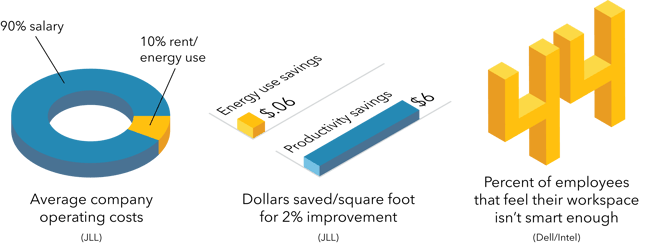The global carbon footprint of the built environment
The environmental impact from buildings can be broken down into different categories. One way of distinguishing it is by looking at the impact from constructing the building versus the energy needed for everyday operations. Overall, the lifetime use of the building accounts for 28% of GHG emissions, compared to 11% from the initial construction and materials1.

Of total building emissions, 65% of greenhouse gases come from indirect emissions through electricity and heat production2. Therefore it is very important to reduce wasted energy and improve the efficiency of your building. Thankfully, we at Airthings are here to help! This list will walk you through all the ways Airthings for Business products will both help you reduce your impact and cut costs while doing it.
Table of Contents:
1. Why should you care about the environment?
2. How Airthings can help:
- CO2 in your business
- Temperature in your business
- Humidity in your business
- Mold in your business
- Light in your business
- Noise in your business
- PM in your business
- Differential pressure in your business
3. All together now
Why should you care about the environment? 
The UN’s Sustainable Development Goals help guide the global community towards creating actionable change. Regionally, countries and cities have been implementing their own recommendations and regulations to reduce the impact of their built environments3.

Improving the efficiency of commercial buildings would have a number of positive spillover effects according to an IPCC Report. This also includes a positive impact on employment and the ecosystem, greater energy security, increased productivity, reduced outdoor pollution and increased indoor environmental conditions4. This is a win-win situation for people, the planet, and your business.
How Airthings can help
Each of the Airthings for Business products can help you reduce your carbon footprint and together they can really help cut your overall environmental impact. By understanding your building and measuring your air quality, you can better control both the indoor environment and minimize the required energy needed to maximize the comfort and functionality of your building. There are three main ways we help better your building: (1) reducing energy use,
(1) reducing energy use,
(2) improving the longevity of your building,
(3) minimizing your direct impact on your tenants and local ecosystem.
We will walk you through how using our sensors to monitor your building can lead to data-driven decision making to improve your building.

Tracking CO2 concentrations in your building is probably one of the most important ways you can use Airthings for Business to save you money and reduce your environmental impact. High CO2 levels can indicate overcrowded meeting rooms, as more people exhale more carbon dioxide.
The best way to improve efficiency in your building is to ensure you are not wasting energy on heating, cooling, and lighting rooms that aren't being used. Tracking patterns of occupancy and using this to inform HVAC operations can minimize wasted energy and maximize employee performance.

Lowering the thermostat just 1 degree celsius, from 19 to 18, in the winter can reduce energy consumption by 10%5. In some warmer climates, raising the temperature 4 degrees can cut the energy used on cooling by as much as two thirds6. That’s a lot of potential savings.

High humidity can promote the growth of bacteria7 and dust mites8 and cause respiratory illness and exacerbate asthma symptoms9. It promotes mold, which can damage your building.
On the other hand, low indoor humidity can cause symptoms, such as dry eyes and a runny or stuffy nose11, and is a leading cause of complaints in office environments12. It can also exacerbate the effects of indoor air pollutants such as PM and can help spread of viruses such as the flu and Covid-1913. To reduce costs associated with absenteeism and building damage, maintaining optimal humidity of 30-60% is vital.
Water, from high humidity levels or condensation caused by high differential pressure, can get trapped in  walls, causing moisture damage and promoting mold growth. By understanding your mold risk and maintaining properly balanced pressure, you can prevent this and maintain a healthy building for your tenants. Preventing long-term damage also reduces costs of mitigation and the environmental impact associated with mold remediation14.
walls, causing moisture damage and promoting mold growth. By understanding your mold risk and maintaining properly balanced pressure, you can prevent this and maintain a healthy building for your tenants. Preventing long-term damage also reduces costs of mitigation and the environmental impact associated with mold remediation14.
 Turning the lights on only when needed is a great way to reduce your energy bill and impact. If an office is already full of natural light, why pay for electricity to turn on an unnecessary light? And wasting energy lighting up areas that aren’t being used doesn’t just pollute the environment with greenhouse gases, it also creates light pollution, which can be detrimental to flora15 and fauna16.
Turning the lights on only when needed is a great way to reduce your energy bill and impact. If an office is already full of natural light, why pay for electricity to turn on an unnecessary light? And wasting energy lighting up areas that aren’t being used doesn’t just pollute the environment with greenhouse gases, it also creates light pollution, which can be detrimental to flora15 and fauna16.

We all know it can be difficult to concentrate in a noisy environment, which could potentially impact your bottom line if workers can't concentrate or tenants complain about sound levels. Noise pollution is also a problem impacting our ecosystem so understanding how your building contributes is important for reducing your impact to this environmental issue17. Monitor noise (without recording sound) with Airthings for Business today.

Particulate matter (PM) is a range of particles of dust, dirt, and liquids that become suspended in the air18. Some of these are large enough to see, like smoke, smog, or soot. High levels of PM could indicate an issue with your boiler19 or HVAC system20. Inefficient furnaces or malfunctioning HVACs21 can waste energy as well as contributing to greater pollution of PM, which contributes to global warming.

Optimizing indoor air quality metrics can minimize costs and environmental impact. But don’t let all of your efforts to improve your air go to waste! Without a properly balanced building, all of these contaminants can be pulled into your building, while heat can leak out.

All together now
Reduced energy consumption (cut waste and optimize use)
Many of our sensors enable you to take charge of your energy usage and make informed decisions about how and where to efficiently use energy in your building. Minimizing waste and protecting against energy leaks are some of the ways you can cut your electricity bill and your carbon footprint. 
Improved building performance and longevity (reduced moisture damage, mold, etc)
There are a few ways to minimize the impact of construction, such as choosing more sustainable materials. But as a building owner, one of the biggest ways to reduce this impact is to take good care of your building. Since you already have a completed building, ensuring your building has a nice, long lifespan not only reduces your costs in having to make repairs but also the environmental impact associated with those fixes.
Improved indoor and outdoor environment (improved IAQ, thermal comfort, etc)
By using Airthings for Business products, you can reduce absenteeism and maximize employee productivity. Creating a comfortable, pollutant-free environment will help not only those within the building, and lead to happier customers, but also help the world outside your building as well. Especially being aware of noise and light pollution and mitigating any potential sources of particulate matter will improve your direct contribution to your local ecosystem.

References
- https://www.worldgbc.org/embodied-carbon
- https://www.ipcc.ch/site/assets/uploads/2018/02/ipcc_wg3_ar5_chapter9.pdf
- https://ec.europa.eu/info/news/focus-energy-efficiency-buildings-2020-feb-17_en, https://www.iea.org/policies?sector=Buildings
- https://www.ipcc.ch/site/assets/uploads/2018/02/ipcc_wg3_ar5_chapter9.pdf
- https://assets.publishing.service.gov.uk/government/uploads/system/uploads/attachment_data/file/128720/6923-how-much-energy-could-be-saved-by-making-small-cha.pdf
- https://www.ipcc.ch/site/assets/uploads/2018/02/ipcc_wg3_ar5_chapter9.pdf
- https://www.tandfonline.com/doi/abs/10.1080/23744731.2016.1206430
- https://www.niehs.nih.gov/health/topics/agents/allergens/dustmites/index.cfm
- https://www.sciencedirect.com/science/article/pii/S0360132321002912?via%3Dihub#bib18
- https://www.sciencedirect.com/science/article/pii/S0360132321002912?via%3Dihub#bib18
- https://www.sciencedirect.com/science/article/pii/S0160412018320725#bb0285
- https://www.sciencedirect.com/science/article/pii/S1438463917306946
- https://www.nature.com/articles/s41598-021-89078-7
- https://www.epa.gov/mold/mold-remediation-schools-and-commercial-buildings-guide-chapter-1
- https://besjournals.onlinelibrary.wiley.com/doi/full/10.1111/1365-2745.12551
- https://environmentalevidencejournal.biomedcentral.com/articles/10.1186/s13750-019-0151-9
- https://www.science.org.au/curious/earth-environment/noise-pollution-and-environment
- https://www.blf.org.uk/support-for-you/air-pollution/types
- https://www.ncbi.nlm.nih.gov/pmc/articles/PMC6023219/
- https://www.epa.gov/sites/production/files/2014-08/documents/occupants_guide.pdf
- https://www.ncbi.nlm.nih.gov/pmc/articles/PMC2796751/
 Most popular
Most popular
 NEW
NEW




 Radon
Radon
 Radon
Radon







